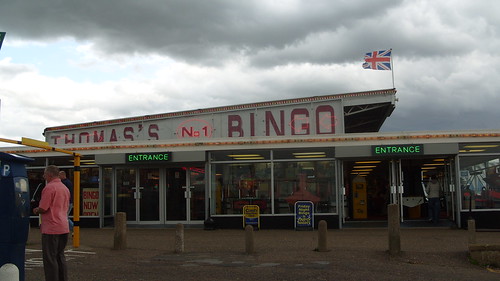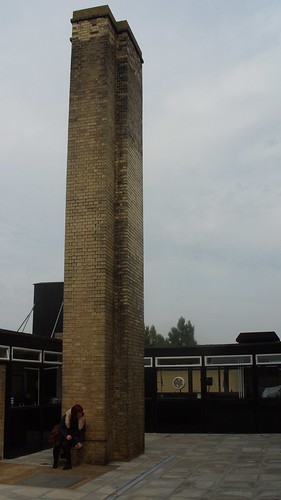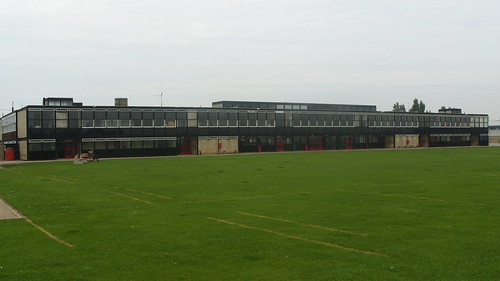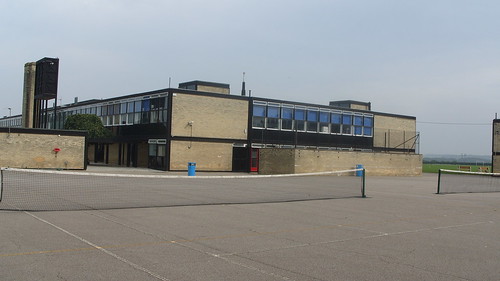
We stayed in a road called 'The Drift', in Heacham. This is a former fishing village, now minor beach resort, on the north coast of Norfolk, looking over the Wash. In the 1790s Norfolk (soon to be supplanted by Lancashire as Britain's industrial area) was a hotbed of Jacobinism. The'Heacham Declaration' announced the formation of an early, universal trade union, swiftly suppressed under the sedition act. Today it is a small village (Victorian and earlier) bookended by, at one side a series of bungalows, and at another, towards the beach, caravan parks. Both are a kind of quotidian minimal architecture, bereft of ornament, but somehow unobtrusive in their modernity. The most impressive minimal architecture in Heacham is the Pillboxes.

They look over the North Beach, in case the Nazis attack via The Wash. What two men in bunkers could have done against the Wehrmacht is a moot point.

Three miles from Heacham is Hunstanton, a proper seaside resort, with Penny Arcades, shops called things like 'Geezer's Palace', amusements including arcade games of the mid-80s (Track and Field!), and so forth. Like all seaside towns it has gone to seed in an interesting way. At the seafront are curved concrete walls to prevent floods. Also like all seaside towns, concrete and Modernism are quietly, blithely acceptable, perhaps because the purpose is hedonism, however circumscribed, rather than English home-making.

The most famous thing about Hunstanton, although it doesn't feature on the postcards, is a much less blithe kind of Modernism: the Hunstanton Secondary Modern School. Designed by Alison and Peter Smithson in 1949, while they were (remarkably) in their early 20s, it is as far from seaside jollity and all its cheerful crapness as could possibly be imagined.

Practically anyone interested in 20th century architecture will have seen it in photographs, the water tower at the entrance and the severe geometries. 'The first New Brutalist Building', 'the most truly modern building in Britain'. This gives you absolutely no hint of just how wildly incongruous it is with the surrounding area. In amongst the bungalows and such, this sleek, ruthless object. The Smithsons spoke of the building having two lives - one as a noisy comprehensive school, 'and another life when the building is empty, a life of pure space'. Me and my sister go there on a Sunday. The gates are open, so we get the life of pure space. The 'found objects' element you always see in photos is the metal water tower, not the even stranger, even starker brick tower behind it.

Yet it's just a secondary school. Its fame worldwide seems to accord with its obscurity in Norfolk. A perfect example of Welfare State ethics in its most extraordinary form - a sublime object dropped, seemingly at random, landing in the midst of an unremarkable English everyday. Now, of course, rather than being truly comprehensive it 'specialises' in Maths and Computing, in that offensive Blairite manner - something that polymaths like the Smithsons, enthusiasts for art, pop, science, philosophy, would undoubtedly have been depressed by - but Secondary Modern will always be the phrase associated with it, with the latter of the two words stressed.

The length of the main block is almost a shock, the deliberate aestheticism and imposition. Without ever using the raw concrete that Brutalism would be known for, it creates the sense of power and force, the memorable image, that the style brought to Modernism. Even the additions, the black panels on the main block's windows (to stop the sea winds smashing them) seem to reinforce the buildings' domineering effect. All this at one storey high, with De Stijl colours and stock brick - pointedly not the local stone and ragged brickwork which features in so many buildings in the area, which itself seems a Dutch importation, has something rather continental about it.

At the back are fields which seem to go on forever. The endless Norfolk flatlands, with barely a hill all the way to the Urals.

They look over the North Beach, in case the Nazis attack via The Wash. What two men in bunkers could have done against the Wehrmacht is a moot point.

Three miles from Heacham is Hunstanton, a proper seaside resort, with Penny Arcades, shops called things like 'Geezer's Palace', amusements including arcade games of the mid-80s (Track and Field!), and so forth. Like all seaside towns it has gone to seed in an interesting way. At the seafront are curved concrete walls to prevent floods. Also like all seaside towns, concrete and Modernism are quietly, blithely acceptable, perhaps because the purpose is hedonism, however circumscribed, rather than English home-making.

The most famous thing about Hunstanton, although it doesn't feature on the postcards, is a much less blithe kind of Modernism: the Hunstanton Secondary Modern School. Designed by Alison and Peter Smithson in 1949, while they were (remarkably) in their early 20s, it is as far from seaside jollity and all its cheerful crapness as could possibly be imagined.

Practically anyone interested in 20th century architecture will have seen it in photographs, the water tower at the entrance and the severe geometries. 'The first New Brutalist Building', 'the most truly modern building in Britain'. This gives you absolutely no hint of just how wildly incongruous it is with the surrounding area. In amongst the bungalows and such, this sleek, ruthless object. The Smithsons spoke of the building having two lives - one as a noisy comprehensive school, 'and another life when the building is empty, a life of pure space'. Me and my sister go there on a Sunday. The gates are open, so we get the life of pure space. The 'found objects' element you always see in photos is the metal water tower, not the even stranger, even starker brick tower behind it.

Yet it's just a secondary school. Its fame worldwide seems to accord with its obscurity in Norfolk. A perfect example of Welfare State ethics in its most extraordinary form - a sublime object dropped, seemingly at random, landing in the midst of an unremarkable English everyday. Now, of course, rather than being truly comprehensive it 'specialises' in Maths and Computing, in that offensive Blairite manner - something that polymaths like the Smithsons, enthusiasts for art, pop, science, philosophy, would undoubtedly have been depressed by - but Secondary Modern will always be the phrase associated with it, with the latter of the two words stressed.

The length of the main block is almost a shock, the deliberate aestheticism and imposition. Without ever using the raw concrete that Brutalism would be known for, it creates the sense of power and force, the memorable image, that the style brought to Modernism. Even the additions, the black panels on the main block's windows (to stop the sea winds smashing them) seem to reinforce the buildings' domineering effect. All this at one storey high, with De Stijl colours and stock brick - pointedly not the local stone and ragged brickwork which features in so many buildings in the area, which itself seems a Dutch importation, has something rather continental about it.

At the back are fields which seem to go on forever. The endless Norfolk flatlands, with barely a hill all the way to the Urals.
Originally posted at SDMYABT on 06/09/08







